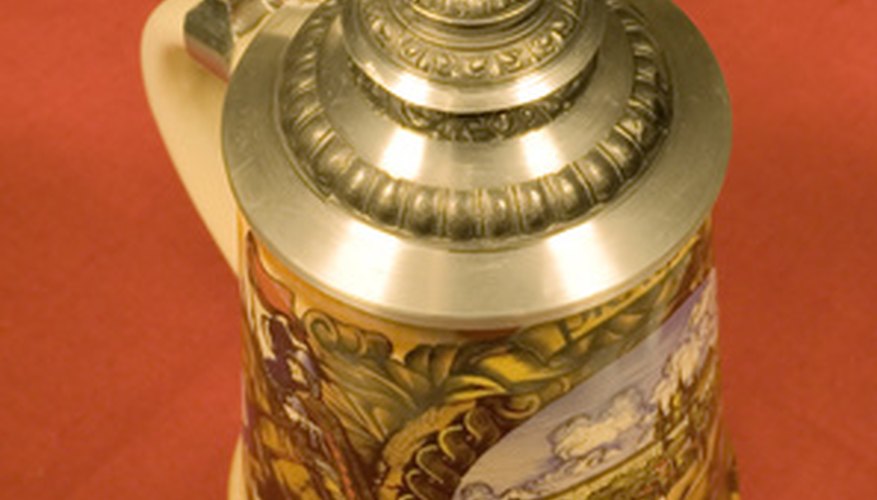German beer steins are covered mugs, or tankards. The cover owes its origin to medieval health regulations meant to stop the spread of plague. The cover was supposed to prevent the beer's contamination by flies. Improvements in firing techniques produced a strong stoneware vessel. The gradual introduction of other types of ceramic, such as faience, and the use of glass, pewter and even ivory encouraged the development of more elaborate designs. German beer steins are often highly decorated, and come in a variety of styles and sizes.
Early Steins
The earliest surviving German beer steins date from before 1700. Examples from this period are easily identified by region. The modern country of Germany was created in 1871. Before that, the term "Germany" referred to all the German-speaking lands, including Austria, Switzerland and adjacent territories. Steins from southern areas such as Bohemia and Austri, were noted for their solid appearance and generally wide profile. Northern Germany produced steins that were tall and slender. The eastern and western parts of Germany also favoured different forms of decoration and colouring. Western beer steins were typically of stoneware with blue decoration, while those from the east featured stoneware with a brown glaze.
- The earliest surviving German beer steins date from before 1700.
- The eastern and western parts of Germany also favoured different forms of decoration and colouring.
Standard-Shaped Steins
After 1700, steins assumed a standard shape. German beer steins are cylindrical with a width equal to about half their height. 18th century steins often feature massive pewter ornaments, no matter the material of the stein. Pewter was used for lids, hinges and handles. These pewter fittings were often richly engraved. These fittings become smaller and less elaborate after about 1850. From 1850 to 1865, the pewter fittings took the form of rings that enclosed ceramic or glass lids. While from 1875 to 1914, inexpensive steins once again featured large pewter lids and thumb lifts. Only the more expensive German beer steins continued the tradition of inlaid ceramic lids with small fittings.
- After 1700, steins assumed a standard shape.
- From 1850 to 1865, the pewter fittings took the form of rings that enclosed ceramic or glass lids.
Stein Lids
Lids are among the most importance features of German beer steins. Inexpensive, mass-produced examples feature high, cone-shaped lids. These are rarely decorated in any noticeable way. Flat lids, however, can be beautifully engraved and will command higher prices than conical lids. Ornamental pewter lids are similar in outline to the standard cone-shaped lid, but are usually much larger and topped with a finial. Both lid and finial can be carved into a variety of shapes. Lids often are chased, or decorated with fine handmade cravings or etchings. Inlaid lids represent a still more expensive variation on the ornamental pewter lid. A pewter rim and flange, or lip, surround a ceramic circle topped by a stoneware finial. Finials are like miniature statues. More unusual lids and finials may even be made of glass or wood.
- Lids are among the most importance features of German beer steins.
- Both lid and finial can be carved into a variety of shapes.
Carved Steins
Many German beer steins are elaborately carved. The mug is carved while the ceramic is still wet. Pieces may feature figures in relief on the surface of the German beer mug, or finer lines that are the result of etching or incising. Carvings often represent scenes from folk tales or regional lore. German patriotic motifs also were popular, as were regimental designs from the Imperial German army. Soldiers often had personalised pieces produced to commemorate their years of service. Carefully hand-carved pieces bring higher prices than mass-produced examples. Carvings are typically finished with various glazes that bring the figures and scenes to life. The inside of a stein is usually white.
- Many German beer steins are elaborately carved.
- Pieces may feature figures in relief on the surface of the German beer mug, or finer lines that are the result of etching or incising.
Patents and Other Marks
German beer steins by individual makers can be identified by patents and other marks. Look for patent information that is stamped or incised onto the German beer mug. Steins also may bear a maker's mark. Patents and makers' marks can both help to date a particular piece. Many manufacturers used a variety of different marks over time. Stein Collectors International provides images of some of the more common marks. Some pieces even bear an artisan's signature. Mettlach, Reinhold Merkelbach, Albert Jacob Thewalt, Villeroy and Boch, and others have been making German beer steins since the 19th century. The period from 1860 to 1914 is considered the Golden Age of the German beer stein. Prized pieces have commanded as much as £78,000.
- German beer steins by individual makers can be identified by patents and other marks.
- Patents and makers' marks can both help to date a particular piece.
